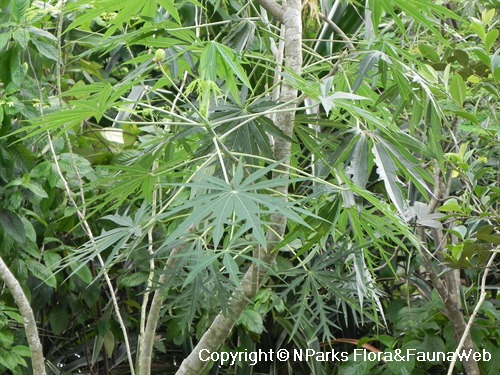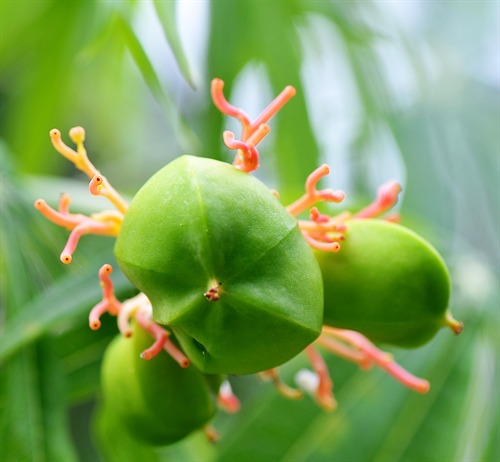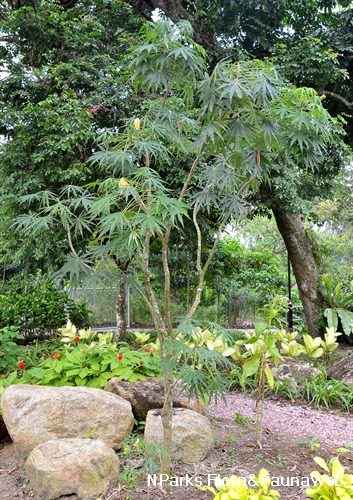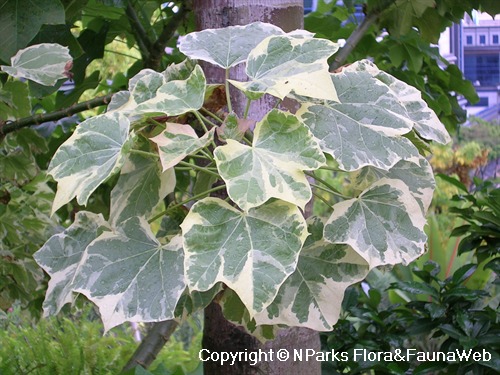
Name
Classifications and Characteristics
| Plant Division | Angiosperms (Flowering Seed Plants) |
|---|---|
| Plant Growth Form | Tree (Shrubby (1m-5m)), Shrub |
| Lifespan (in Singapore) | Perennial |
| Mode of Nutrition | Autotrophic |
| Maximum Height | 6 m |
Biogeography
| Native Distribution | Tropical and subtropical America |
|---|---|
| Native Habitat | Terrestrial |
| Preferred Climate Zone | Tropical, Sub-Tropical / Monsoonal |
| Local Conservation Status | Non-native (Horticultural / Cultivated Only) |
Description and Ethnobotany
| Foliage | Large, palmately cut into 9-11 deep narrow lobes., up to 30cm across. |
|---|---|
| Flowers | Borne in clusters, flowers are bright coral red with small yellow petals, resemble a piece of coral. |
| Fruit | Green to yellow when matured, usually 3 angled capsule. The capsule does not open on its own at maturity like some of other Jatropha species do. |
| Ethnobotanical Uses | Medicinal: All parks of the plant have been widely used in traditional folk medicine in many parts of West Africa. The seeds haven been used as a purgative, anthelmintic and abortifacient as well as for treating ascites, gout, paralysis and skin diseases. The seed oil of the plant has been used as an ingredient in the treatment of rheumatic conditions, itch and parasitic skin diseases. The bark and leaves are used as medicine for neurodermatitis, itchy skin and skin eczema. |
Landscaping Features
| Desirable Plant Features | Ornamental Flowers |
|---|---|
| Landscape Uses | General, Parks & Gardens, Container Planting, Suitable for Bonsai |
| Usage Hazard - Cons | Toxic Upon Ingestion |
| Usage Hazard - Cons Remarks | All parts are toxic but in particular the seeds. |
Fauna, Pollination and Dispersal
| Fauna Pollination Dispersal Associated Fauna | Butterfly-Attracting (Flower Nectar) |
|---|
Plant Care and Propagation
| Light Preference | Full Sun, Semi-Shade |
|---|---|
| Water Preference | Little Water |
| Plant Growth Rate | Fast to Moderate |
| Rootzone Tolerance | Drought Tolerant, Well-Drained Soils |
Foliar
| Foliage Retention | Evergreen |
|---|---|
| Mature Foliage Colour(s) | Green |
| Mature Foliage Texture(s) | Smooth |
| Foliar Type | Simple / Unifoliate |
| Foliar Arrangement Along Stem | Alternate |
| Foliar Attachment to Stem | Petiolate |
| Foliar Shape(s) | Non-Palm Foliage (Palmate) |
| Foliar Venation | Palmate |
| Foliar Margin | Palmately Lobed |
Floral (Angiosperm)
| Flower Colour(s) | Red |
|---|---|
| Flower Grouping | Cluster / Inflorescence |
| Flower Location | Axillary |
| Flowering Period | Free-Flowering, Hot & Dry Period |
Image Repository
Others
| Master ID | 29788 |
|---|---|
| Species ID | 4097 |
| Flora Disclaimer | The information in this website has been compiled from reliable sources, such as reference works on medicinal plants. It is not a substitute for medical advice or treatment and NParks does not purport to provide any medical advice. Readers should always consult his/her physician before using or consuming a plant for medicinal purposes. |







.jpg)
